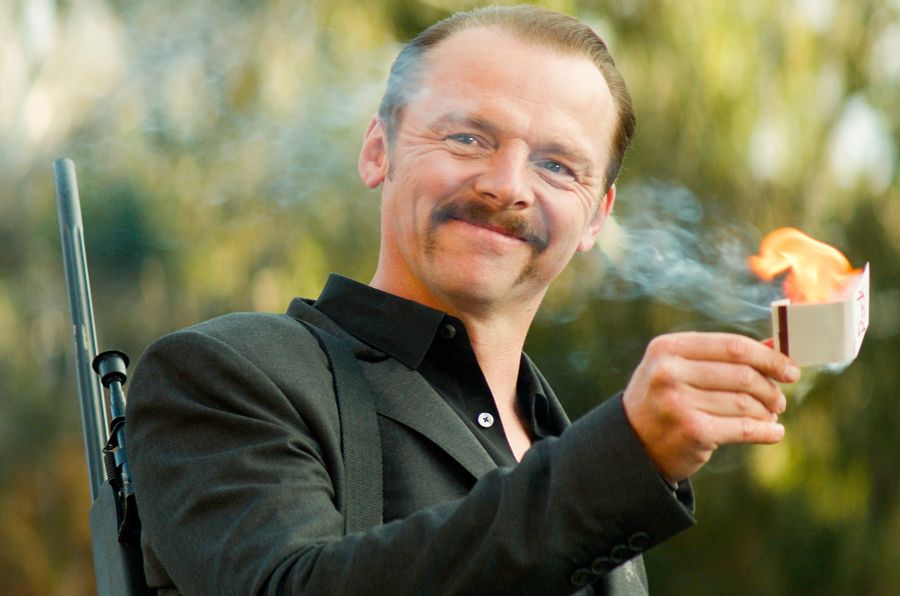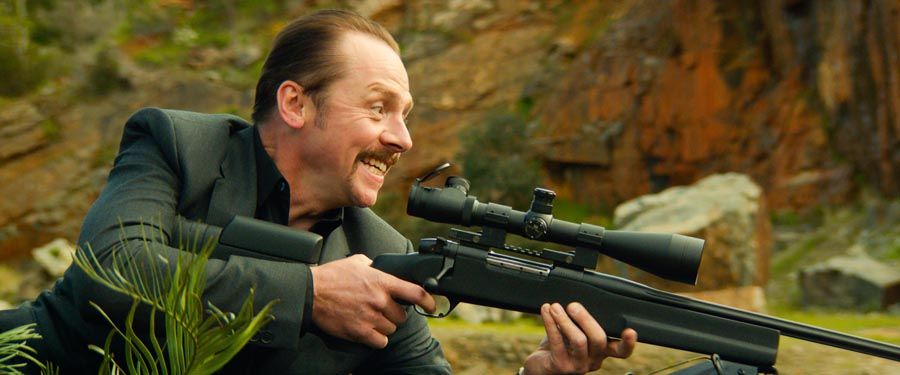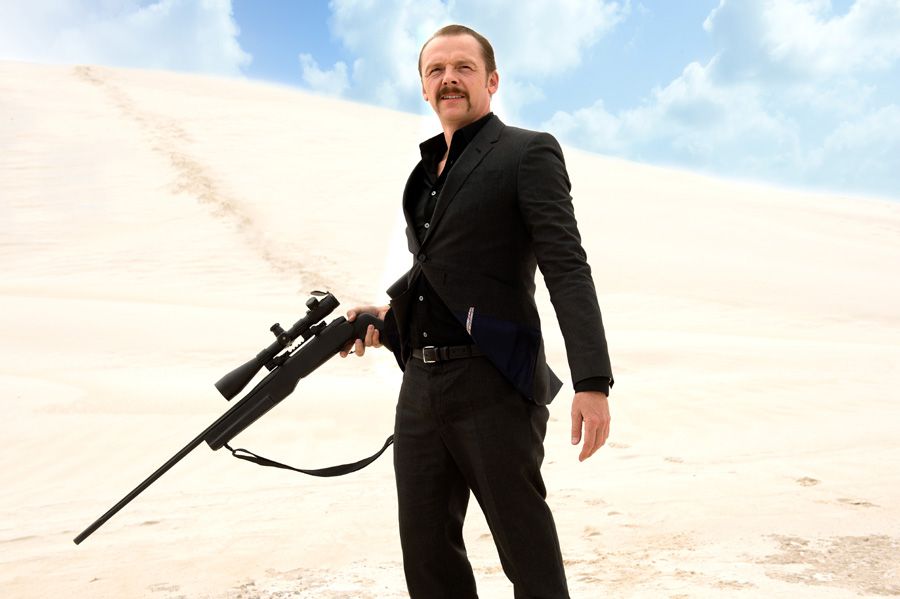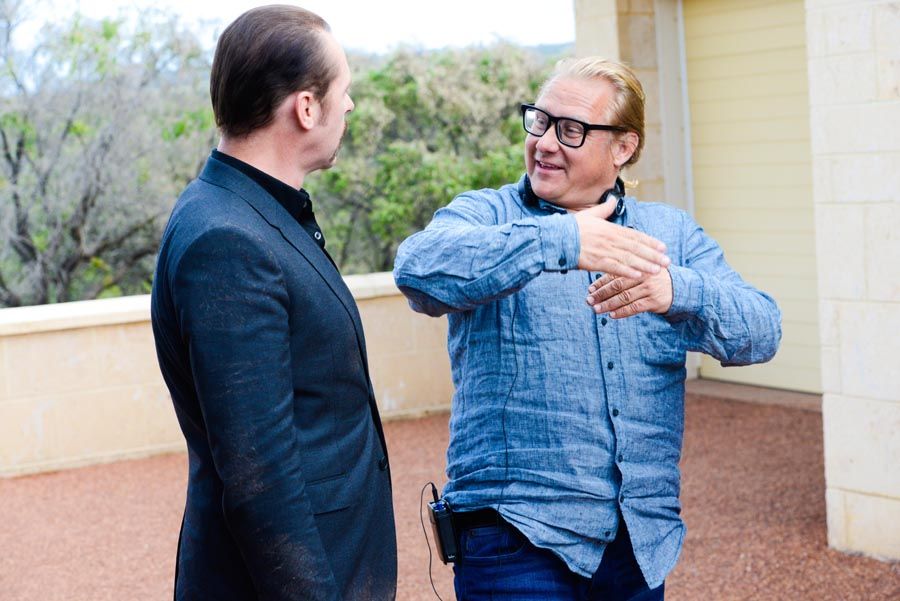For Simon Pegg, the opportunity to play a morally bankrupt hit man who also happens to be the most likeable character in sight in “Kill Me Three Times” was an opportunity he couldn’t pass up.
With a tiny window in his increasingly busy shooting schedule, Pegg high-tailed it to Perth, Australia, to join an international cast of the off-kilter thriller, including Alice Braga, Sullivan Stapleton, Teresa Palmer, Luke Hemsworth and Bryan Brown. Directed by Kriv Stenders, known for his acclaimed 2011 breakout film “Red Dog,” the knotty story blends elements of crime noir, Tarantino-esque lowlife and classic comedies of error in a uniquely eccentric narrative.
Pegg and Stenders recently met with journalists for a roundtable discussion to reveal how the actor’s zip-in, zip-out role suddenly found itself at the heart of the twisting, turning storyline.
Nailing down the pacing, the tone, the setting, how evident was it to you guys on set what this final product was going to look and feel like? And how much did that play into what you were doing on set?
Kriv Stenders: The script really, when I first read it, it presented itself quite strongly as something I thought was a lot of fun, and it had a particular rhythm, a particular vibe. It’s kind of almost like a pop song or a rock song. You can feel the rhythm. So it was really just a matter of having fun with it and getting the cast together, and everyone realizing that we’re all dancing to the same song. Simon coming on board really kind of gave us a great platform from which to sort of keep moving. And everyone was in synch, I think, from that point on.
Simon Pegg: For me it was interesting because I came in at the very beginning. I had limited time, so we had to sort of get my stuff in during a certain period, which meant that we shot the beginning of the film and the climax of the film in the same fortnight. So it was really fun to watch the final film and see all the constituent parts that I did interlaced with everything else. Obviously, the film is multilayered, and there’s different narratives. I got to work with everybody, but it was really fun to watch their stories. It was nice because I kind of had this brief in and out, and then they got on without me.
How was playing that badass character? Usually you’re kind of the nice guy.
Pegg: It was more like me. I’m far more like an amoral mass murderer than any of the nice guys that I play. No, it was fun. It was nice to do something different. One of the things that attracted me to the script, apart from the artful way that it was structured and written was the opportunity to play someone very contrary to some of the roles I’ve played before. And Charlie was just a delight on the page, to play someone who is so unapologetically bad. At yet at the same time oddly, kind of the most likable person in the film [laughs], which says a lot about everyone else in the movie, the other characters. I couldn’t resist it. I had to pack my bag and go to Perth immediately.
Related: Simon Peg Promises "Frontierism" and "Optimism" in "Star Trek 3"
When a character is somewhat unlikable, and yet you also make him fun to watch. Can you talk about finding out how to do that?
Pegg: I think it helps that everyone in Eagle’s Nest is a bit of an idiot. It’s kind of like, you have to pick your allegiance. I suppose Alice and Luke are the most probably morally acceptable people, even though they’re up to no good. They’re having an affair, and they’re stealing money and stuff. Charlie, as a villain, there’s a lot of fun about him. His amusement at it all is parallel to the audience’s own amusement. The audience come in with Charlie and they get to look at the craziness that’s going on in that small town with him and be as bemused and disgusted and sort of maddened by it as he is which is an interesting angle for the audience to have their POV be the bad guy, really.
If he wasn’t fun, Charlie, he would be horrendous. It would be like watching “Wolf Creek.” Although, admittedly the bad guy in that is kind of fun but in a way that’s horrific. In a film that has this much violence in it, if it was just sort of lead pipe cruel, it would be really hard to watch. It has to be heightened and made fun in order to make it a bit more palatable.
Can you talk about the mustache and the Johnny Cash look? How’d you come up with that look?
Pegg: Well, me and Kriv sort of came up with it together before we started shooting. We had a couple of Skype conversations and phone calls before we officially met in the flesh and talked about Charlie and what he would look like. I kind of pushed for the mustache. I regretted it immediately as soon as it happened because I couldn’t wear any of my clothes with it. It was the most bizarre thing. Such a tiny thing can say so much about you, though.
I’ve got nothing against the handlebar, it’s a great look, but you have to pair it with certain aesthetics, and it doesn’t look good with anything other than a baseball cap and a plaid shirt. So it was difficult. Or a cowboy hat. Or a construction worker’s helmet. Any of the Village People It was just an idea that we had. I realized in talking to Kriv that we wanted this sort of incongruous figure. He’s the Grim Reaper. He looks as incongruous in that setting as a man in a cloak with a scythe. And Charlie has no interest in being stealthy. He’s very brazen in what he does. He clearly looked at the big book of hit men and said I want to look like that.
Can you talk about the music? The music is great.
Stenders: The composer is an Australian who actually lives here. A fellow by the name of Johnny Klimek. I was a big fan of Johnny’s films. He’s worked for the Wachowski brothers and Tom Tykwer, and he did the soundtrack to “Run Lola Run,” which is one of my all-time favorite soundtracks and films. One of the ways in which I was pitching the film to the crew, saying, "Look. Think of this as an American movie that just happens to be shot in Australia."
Same with Johnny. Look, I want to make an international movie. I wanted to be like a sports car. I wanted to look good, be fast, and be fun to ride. As I said before, the script read to me like a rock song. It had this great pulse, this great rhythm to it. Had a great beginning, some great choruses, a great bridge, and a few great solos with a fantastic finale. We just hit on this idea. We were trying to find a motif. We were trying to find kind of a musical idea or hook to kind of hang the film on. And we tried a few things. I even said, "Oh, let’s use saxophones." There’s a bit of an '80s vibe in the film.
Pegg: It’s very “Lethal Weapon.”
Stenders: But then it was interesting, we stuck on the idea of this sort of surf guitar. That was the little kind of switch that we’re trying to turn on. Once we found that, it all kind of gelled. And the tone of it, again, fused. And it’s really fun when you find that, finally find that missing ingredient.
The film has so many twists, turns, double backs, reveals. How much of that was laid out pretty specifically in the script, and how much was discovered in the shooting – and maybe even in the editing?
Stenders: Well, I’ll tell you something really interesting. I don’t even know if I’ve told Simon this. The script was told in three chapters. That conceit was inherent in the architecture of the film, but something really interesting happened in the edit. Well, two things happened. In the original script, Charlie only appears in the beginning and end of the film. And whenever we saw Simon we went, "God, Simon’s great! I wish he was throughout the whole film."
So what we did, is during the edit, we actually realized because it was so precisely plotted and so precisely structured, when you’re playing with time in this kind of way, it’s actually a very interesting construction because you can actually take apart what you thought was fundamental that couldn’t move. You can actually move it, and it still worked because you’re still playing with what audiences learned and when. So it was very compartmentalized. So we ended up making the decision to, let’s try and weave Charlie throughout the whole story, which wasn’t in the script. But we still kept the looping back idea intact, but we just ended up getting a lot more Simon in there.
Was there one more scene that was difficult to film than the other?
Stenders: I think openings and beginnings are really tough because you’ve really got to know where the audience needs to be at the beginning and where they need to be at the end, and that’s something very hard to predict sometimes. So I find openings and closings really hard to shoot or hard to kind of get right. You sort of have to follow your instincts. Because of the schedule as well, with Simon’s schedule, we had to shoot everything out in the first two weeks. Which was obviously –
Pegg: A big pain in the ass.
Stenders: – we were more than happy to do because we’re so chuffed that Simon said yes. I think that’s the general, that’s not just for this film, but I think it’s for every film. Those beginnings and endings are really hard.
Pegg: You kind of sometimes feel like if you shoot the beginning at the beginning, which you often do, you sometimes feel at the end you want to go back and shoot the beginning again once you’ve got the whole film. In a way, the beginning should almost be the last thing you shoot, in a weird way.
Do you guys have a favorite moment from being on set?
Stenders: For me, it was every moment. Seriously. And especially every moment with Simon, it was just such a joy. It’s so much fun. This job is so great sometimes when you can have a great script and have a crew. As [Roman] Polanski said, "It’s the best train set in the world." But always shooting in locations is hard because we had a lot of travel, which took time out of the shooting schedule. So there was always a pressure, a time pressure, which can be challenging. But that also kind of focuses everyone. And that pressure, I think, is healthy because you don’t muck around. You’ve just got to go on with stuff. I loved shooting everything.
Pegg: Yeah, I really enjoyed shooting the fight scene with Sullivan [Stapleton] because it was messy. I really got along well with Sully, he’s such a great guy. Being stabbed through the hand for the second time in my career was enormous fun. And whenever you can get down and dirty with something like that is just... so cool in the face of being such an asshole [laughs]. He's such a bastard, but it's so great. We came up with the idea of – I won't give anything away – but there's a point in the movie when Charlie sets something on fire. And as he's walking away from it in the classic movie style, realizes he can't light his cigarette. So he's kind of bummed. He turns around and says, "Aw, man." Like he just killed somebody, like that's what he cares about, the fact that he can't light his cigarette.
Stenders: For the rest of the movie, he's trying to find matches.
In doing this film, did you learn anything about yourself?
Stenders: No, but it's a good question because I think, as a filmmaker, you're always learning, always learning. You look at Kurosawa: he made some like 30 films, and his last films were brilliant. And there's a reason for that, and it is that you actually get better by doing more. And there's no better way of learning about filmmaking than actually filmmaking. So that's what I love about the process, and that's what I think I just felt like I learned so much more about every part of the process, the craft, working with the actors, telling this kind of story, constructing it, shooting it, editing it.
There's a million things that you pick up and learn along the way. And I was just very lucky. I had a great cast on this film. Not that I haven't on my previous films, but this was just so much fun working with an international cast. And having just great actors who are like finely tuned watches, that were just all perfectly in time. So yeah, it was a lot of fun.
Pegg: Never have a handlebar mustache or never, ever shave your facial hair in that configuration again. Yeah, I learned something new on every film I do, and as Kriv said, you do improve in increments as you do more and more work. There's no substitute for the experience, and it was great to work in a place I'd never worked before. Western Australia is such a beautiful and remarkable part of the Earth. I've been to Australia many times but never to that part. So it was a real education to see a kind of greener Australia and topologically a different Australia. And to work with international crews, everything goes into your sort of bank of experience which can only make you a better filmmaker, actor, writer.
Some actors who are action stars are like, "OK. I can do guns in movies or on the set, but once the shoot is gone, here you go, take the guns." How are you about the guns?
Pegg: We had a fun day, didn't we? Shooting that big rifle when we were sort of in a disused psychiatric hospital. Not the first one I've been in actually, to shoot. Yeah, and we had a bit of gunplay. But it's a serious business when you have firearms on set because it can be very dangerous. And there's always a huge and rigorous safety precautions around that, and they're not toys. Like any kid growing up, watching Star Wars and cowboy films or whatever, it's fun to do this. But when you're actually working with firearms, you have to be a little bit careful.
Although having that scope on that rifle, the amount of people I zeroed in when I was up on that rig. I had Larry, the producer, in my sight. I could just... head shot. Right now. Not that I would, Larry's a lovely, lovely man. But having people down there, that you can't help but get in the sights. But having said that: never, never underestimate the safety regulations of an onset firearm, boys and girls.
Available on demand, “Kill Me Three Times” opens today in select theaters.




